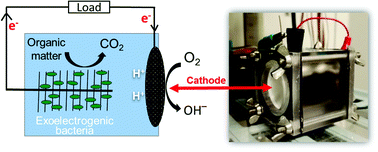The impact of new cathode materials relative to baseline performance of microbial fuel cells all with the same architecture and solution chemistry†
Abstract
Differences in microbial fuel cell (MFC) architectures, materials, and solution chemistries, have previously hindered direct comparisons of improvements in power production due to new cathode materials. However, one common reactor design has now been used in many different laboratories around the world under similar operating conditions based on using: a graphite fiber brush anode, a platinum cathode catalyst, a single-chamber cube-shaped (4 cm) MFC with a 3 cm diameter anolyte chamber, 50 mM phosphate buffer, and an acetate fuel. Analysis of several publications over 10 years from a single laboratory showed that even under such identical operational conditions, maximum power densities varied by 15%, with an average of 1.36 ± 0.20 W m−2 (n = 24), normalized to cathode projected area (34 W m−3 liquid volume). In other laboratories, maximum power was significantly less, with an average of 0.91 ± 0.26 W m−2 (n = 10), despite identical conditions. One likely reason for the differences in power is cathode age. Power production with Pt catalyst cathodes significantly declined after one month of operation or more to 0.87 ± 0.31 W m−2 (n = 18) based on studies where cathode aging was examined, while in many studies the age of the cathode was not reported. Using these studies as a performance baseline, we review the claims of improvements in power generation due to new anode or cathode materials, or changes in solution conductivities and substrates.



 Please wait while we load your content...
Please wait while we load your content...